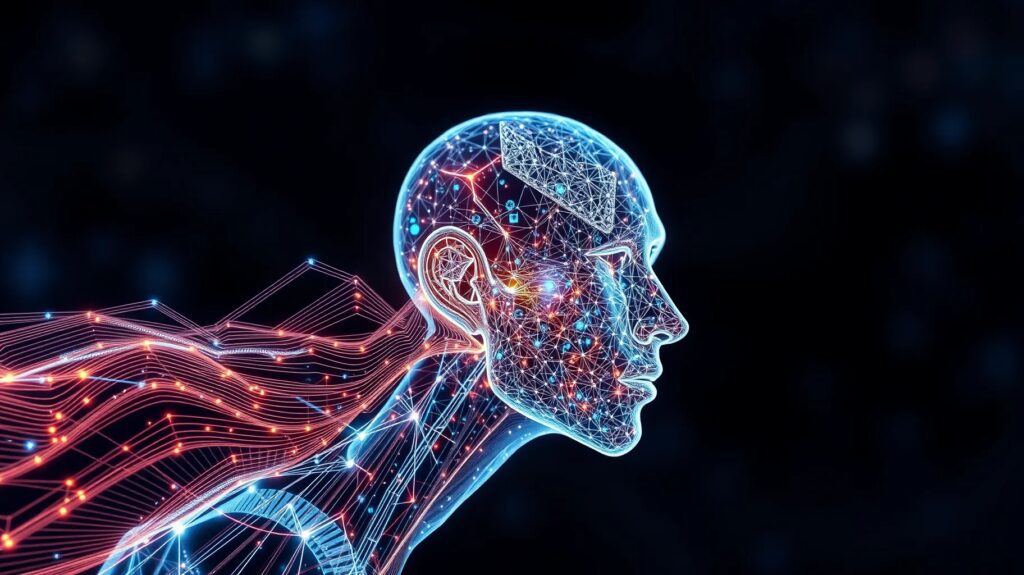
Generative AI has already shaken up industries, sparking curiosity and opening doors to new possibilities across the globe. But as the technology matures, we’re set to see even more profound changes.
The next five years will likely bring about significant advancements and entirely new use cases that could redefine how we work, communicate, and create. So, what trends in generative AI can we expect to emerge? Let’s dive into the future of this transformative technology.
Improved Contextual Understanding in AI Models
1. Enhanced Multimodal Capabilities
As of now, AI models handle multiple modes—like text, images, and sound—pretty well individually. But the next leap is to develop truly integrated multimodal AI systems that understand all forms of data together, with seamless fluidity.
- Unified understanding: Imagine an AI that can interpret a complex request involving image and text, like suggesting design improvements based on an uploaded blueprint and a written description.
- Enhanced creativity: This will make AIs more capable of supporting creative fields, such as generating entire videos from written descriptions or creating artwork with meaningful contextual details.
Google, Meta, and OpenAI are actively investing in multimodal learning for next-generation AI. If successful, these developments will allow businesses to interact with AI in much more intuitive ways, without being limited to one medium at a time.
2. Real-Time Language Translation
AI-powered translation tools have come a long way, but contextual translation remains a hurdle. Over the next five years, we can expect a more natural, real-time approach to language processing.
- Accurate cultural understanding: Future AIs will become fluent in idioms, regional dialects, and even social nuances, bridging global communication gaps.
- Instantaneous translation: Imagine having a virtual meeting where everyone speaks their native language while AI instantly translates each sentence with context.
With these advancements, global companies could streamline international collaborations, opening the doors to more inclusive and productive workplaces.
3. Better Handling of Complex Tasks
A major area for growth is the ability of AI models to perform complex, multi-step tasks. This goes beyond simple text prompts; we’re looking at AI that can analyze, plan, and act autonomously over extended workflows.
- Longer attention spans: AI models will better retain details over longer interactions, enabling them to assist with projects that require multiple rounds of adjustments.
- Task memory: AI that can recall previous tasks or preferences, creating smoother experiences for users and boosting productivity.
In industries like customer service, this could revolutionize how companies manage client interactions, with AI handling follow-up steps and providing seamless support across sessions.
Ethical Advancements and Responsible AI
1. Enhanced Privacy and Data Security
As generative AI becomes more embedded in daily life, privacy concerns are at an all-time high. Future developments will prioritize privacy, driven by both ethical considerations and regulatory pressures.
- Federated learning: This technique allows AI to learn from user data without actually storing it on a central server. Instead, it processes data locally and only shares model updates.
- Encrypted models: Advanced encryption techniques will enable privacy-preserving AI that can handle sensitive tasks like healthcare data analysis.
Privacy-first innovations will be critical as AI expands into sensitive areas, helping people feel secure in their interactions with generative AI.
2. Increased Focus on Bias Reduction
Generative AI models often mirror biases present in their training data, leading to skewed or insensitive outputs. Addressing bias in AI models will become a priority in the coming years.
- Diverse data sourcing: Using data from multiple cultures and communities helps AI learn from a wider perspective.
- Regular audits: Future AI tools will include built-in systems to identify and mitigate biases, adapting to more socially aware and inclusive standards.
By minimizing biases, AI developers can ensure their tools serve a broader audience fairly and responsibly, making AI-driven applications more equitable and accessible.
3. Transparent AI Decision-Making
People want to know why AI makes certain decisions. Explainable AI (XAI) is on the rise, and within the next five years, it’s expected to gain traction, especially in fields like healthcare, finance, and legal.
- Clear reasoning paths: AI will offer simple explanations of how it arrived at specific outcomes, making it easier for users to trust AI recommendations.
- Accountability in high-stakes fields: In areas where AI decisions have serious impacts, transparency will become a requirement rather than a bonus feature.
With better transparency, people will feel more confident using AI, as they’ll be able to understand the reasoning behind AI-driven decisions.
AI for Creative and Business Automation

1. Automated Content Creation with Human-Level Quality
The days when AI-generated content seemed robotic are ending. As AI language models evolve, they’ll produce more nuanced, human-like content that doesn’t feel AI-generated.
- Custom-tailored content: Generative AI will deliver personalized content that adapts based on user preferences and style.
- Editing and feedback loops: Future models could incorporate feedback from users to improve over time, making them highly effective content partners.
From blogging to video production, generative AI will open new doors for both personal and business use, changing the landscape of creative industries.
2. Advanced Virtual Assistants for Business Needs
Generative AI will reshape business operations by providing smarter, more efficient virtual assistants capable of handling complex tasks that go beyond standard queries.
- End-to-end solutions: Virtual assistants could take on entire tasks, such as coordinating project timelines, managing emails, or drafting reports.
- Deep integration with business software: Advanced AIs will work seamlessly with CRM, ERP, and other business systems, allowing them to interact and make recommendations based on real-time business data.
These powerful assistants will allow companies to operate at new levels of efficiency while freeing up human employees for more strategic work.
3. Personalized Marketing on a New Level
AI will transform the marketing industry by enabling unprecedented levels of personalization. With access to massive amounts of consumer data, future AIs will craft tailored marketing campaigns that feel one-on-one.
- Hyper-personalized messaging: AI-driven marketing will adapt based on individual customer preferences, delivering content that resonates with specific needs and behaviors.
- Predictive engagement: AI will anticipate when and how to interact with users, boosting conversion rates and improving customer satisfaction.
This will enable brands to form deeper connections with their audiences, refining marketing campaigns to achieve higher engagement and loyalty.
Expansion of AI in Real-World Applications
1. AI-Powered Healthcare Innovations
Generative AI is already making strides in healthcare, and the future looks even more promising. With improved diagnostic capabilities and predictive healthcare models, AI will support medical professionals in more impactful ways.
- Personalized treatment: AI can recommend treatment plans tailored to individual genetic makeup, lifestyle, and health history.
- Efficient medical imaging analysis: Generative AI models will be able to interpret X-rays, MRIs, and other imaging results faster and more accurately than ever.
These advancements will lead to more precise, efficient care for patients and allow doctors to make better-informed decisions.
2. Generative AI in Environmental Sustainability
Generative AI has the potential to make significant contributions to environmental science, aiding in sustainable development and conservation efforts worldwide.
- Climate modeling: Advanced models can generate highly accurate climate predictions, helping organizations prepare for natural disasters.
- Waste management: AI could analyze waste and propose recycling or upcycling methods, improving resource efficiency.
As environmental issues take center stage, generative AI will play a vital role in creating solutions for a more sustainable future.
Generative AI in Education and Skill Development

1. Personalized Learning Experiences
AI-driven educational tools are already helping students learn at their own pace, but future systems will go even further in personalizing learning for each student’s unique strengths and weaknesses.
- Tailored lesson plans: Generative AI can analyze a student’s learning style, performance, and areas for improvement, offering resources and tasks that match their needs.
- Adaptive assessments: AI-powered assessments can adjust questions based on a student’s answers in real-time, offering a customized learning journey that builds their confidence.
By using AI in this way, educational institutions can provide a more engaging and effective learning experience, leading to better outcomes for students.
2. Virtual Tutors and Interactive Study Assistants
Over the next few years, AI-powered virtual tutors will become more interactive and capable of providing detailed feedback and guidance in a human-like manner.
- 24/7 availability: Virtual tutors will allow students to access help anytime, regardless of their location, which is especially useful for remote learning.
- Interactive simulations: For fields like science, engineering, and medicine, AI-driven simulations will allow students to engage in virtual labs and hands-on learning exercises, deepening their understanding through practice.
This will make education more accessible to diverse learners, fostering a supportive environment where students can learn at their own pace with individualized guidance.
3. Skill Development for the Future Workforce
As the job market evolves, generative AI can assist people in developing new skills or transitioning to different industries by providing training programs tailored to industry demands.
- Job-specific training: AI will analyze job market trends and help workers build skills needed in high-demand fields, from programming to healthcare.
- AI-based career coaching: Generative AI can suggest training paths and resources for individuals based on their current skill set and career aspirations, making career changes smoother and more strategic.
With the help of AI, individuals can continuously adapt to the shifting job market, staying competitive and ready for future workforce needs.
AI-Powered Tools for Creative Arts and Entertainment
1. Music Composition and Audio Generation
The music industry is already seeing AI-powered tools that assist with composition, but the next five years will bring more sophisticated music generation that supports musicians and producers.
- Customizable sounds and compositions: Artists will be able to use AI to generate custom soundscapes or instrumental pieces based on specific prompts or styles.
- Real-time sound mixing: Future AI tools will offer automatic mixing and mastering, allowing artists to fine-tune their work without needing a full production setup.
This technology will democratize music creation, allowing artists of all skill levels to produce professional-quality music and reach wider audiences.
2. Advanced Animation and Visual Effects
In film, gaming, and advertising, AI is transforming visual effects and animation, making these processes faster and more accessible to creatives.
- Realistic 3D rendering: Generative AI will help animators create lifelike characters, textures, and environments quickly, allowing for more immersive storytelling.
- Automated scene generation: AI can automatically design scenes or apply effects, saving time and resources for creators.
These advancements will let studios and independent creators produce high-quality content on smaller budgets, pushing the boundaries of creativity in entertainment media.
3. Interactive Gaming Experiences
Generative AI will play a huge role in evolving video game experiences. Over the next few years, games will become more dynamic, offering unique interactions tailored to each player.
- AI-driven character interactions: NPCs (non-playable characters) will be able to hold natural conversations, respond to the player’s actions, and make decisions that affect the storyline.
- Personalized gameplay: AI can analyze a player’s style and adapt the game experience, whether by adjusting difficulty or generating quests that fit their preferences.
This trend will lead to more engaging and personalized gaming experiences, attracting new players and deepening immersion for experienced gamers.
Ethical and Regulatory Frameworks for AI Development

1. Establishment of AI Ethics Guidelines
As generative AI becomes more embedded in society, governments and organizations are creating ethics guidelines to ensure responsible AI use.
- Transparency requirements: Regulations will likely require companies to disclose how AI models are trained and what data is used, fostering greater public trust.
- Accountability measures: Ethical guidelines will establish accountability for AI-related harms, ensuring that companies take responsibility for their AI tools.
This shift toward transparency and accountability will build trust in AI technologies and encourage their responsible adoption.
2. Regulations for Deepfake Detection
The ability of generative AI to create realistic images, videos, and voice recordings has raised concerns about deepfakes and misinformation. Regulatory bodies are expected to crack down on these technologies in the coming years.
- AI-powered detection tools: Governments and tech companies will invest in tools that can automatically identify AI-generated content, helping to prevent misuse.
- Digital watermarking: Future policies may require digital watermarks on AI-generated media to distinguish it from authentic content.
By implementing these measures, society can harness the benefits of generative AI while safeguarding against deception and misinformation.
3. Responsible AI Development Standards
Across industries, there will be a push toward setting standards for safe and ethical AI development, creating a more structured landscape for innovation.
- Safety protocols: AI developers may be required to follow standardized protocols to ensure their tools are safe and compliant.
- Bias and fairness standards: Developers will need to adhere to guidelines that reduce bias and promote fairness, which could involve regular testing and adjustments.
By standardizing these practices, companies can foster a more trustworthy AI ecosystem, ensuring that new technologies benefit society as a whole.
Expansion of Generative AI into Everyday Consumer Products
1. Smart Homes and Personal AI Assistants
Generative AI is set to make smart homes even smarter by powering personal AI assistants that can manage multiple aspects of daily life.
- Advanced voice control: AI assistants will become more conversational and responsive, enabling users to control home devices, make schedules, and shop online with ease.
- Proactive assistance: AI assistants will anticipate needs, like reminding users of appointments or adjusting home temperatures based on preferences and patterns.
This will make AI assistants a valuable tool for managing routines, boosting comfort, and simplifying daily tasks at home.
2. AI-Driven Health and Fitness Applications
As consumers focus on health, generative AI will expand its presence in fitness and wellness apps, offering personalized guidance for better health.
- Custom fitness plans: AI will create workout routines tailored to individual fitness levels, goals, and physical constraints.
- Nutrition and lifestyle advice: Generative AI will offer meal plans, mindfulness exercises, and other wellness suggestions based on user input and real-time data.
By providing actionable, personalized health insights, AI can empower individuals to make healthier choices and reach their wellness goals.
3. AI-Enhanced Shopping and Retail Experiences
In retail, generative AI will change the shopping experience through virtual try-ons, smart recommendations, and personalized product design.
- Virtual shopping assistants: AI can help customers find products based on preferences, suggesting items they’re likely to love.
- Product customization: Generative AI will enable shoppers to customize products, from clothing to home decor, creating unique, tailored items.
With these innovations, retail will feel more interactive and personal, allowing consumers to enjoy a curated shopping experience that caters to their tastes.
As we look forward to these exciting advancements, generative AI’s growth promises to impact every facet of our lives—from the way we communicate and work to how we manage our homes and improve our health.
The next five years will see generative AI emerge as an essential tool, pushing the boundaries of creativity, productivity, and connectivity while sparking new discussions around ethics, privacy, and inclusivity. As the technology progresses, we’ll witness a world where AI feels more human, more adaptable, and more integral to our daily lives.
Resources
Future Applications in Business, Education, and Healthcare
- McKinsey & Company’s AI Research: McKinsey offers in-depth reports on AI trends, especially in business applications, economic impacts, and industry transformations over the next few years.
- McKinsey’s AI Insights
- Harvard Business Review (HBR) on AI in the Workplace: HBR regularly publishes articles on how generative AI is transforming the workplace, skill development, and operational efficiency.
- World Health Organization (WHO) on AI in Healthcare: WHO provides guidelines and research articles on the use of AI in healthcare, including privacy considerations and personalized medicine.
Technical Deep-Dives and Open-Source Tools
- Hugging Face: A leader in open-source AI, Hugging Face offers tools, models, and tutorials for developers and researchers interested in working with language models, multimodal AI, and ethical AI implementations.
- AI Alignment and Safety Literature from the Alignment Research Center (ARC): ARC focuses on the safety and alignment of AI systems, offering resources on building AI that aligns with human values and safety protocols.
- The Allen Institute for AI (AI2): AI2 conducts research on AI that advances language processing, image recognition, and ethical AI practices, making many tools and resources accessible to the public.